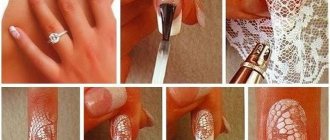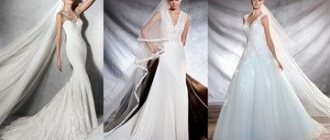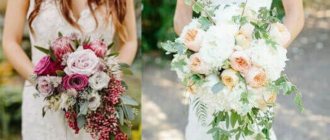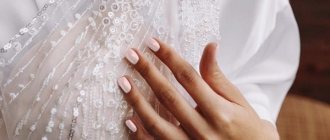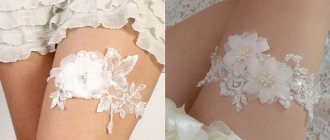Russian folk wedding costume
The solemn and long-awaited wedding day should always be held in the style that the newlyweds choose. There are a lot of themes for weddings, but folk style deserves special attention. The holiday will combine not only specific clothing, but also the traditions of ancestors. The Russian folk wedding costume should have a special place, and it will have to be chosen with the utmost care, it is advisable to even remember historical facts. And grandparents can suggest traditions that have long been forgotten by everyone.
What did the bride's wedding costume consist of in Rus'?
The largest number of cultural reminders about wedding events exists from the times of Kievan Rus. When Christianity was adopted, lovers began to openly celebrate the creation of a new family; this day was given special significance. So, at this time, folk costumes began to develop, which served as the bride’s wedding dress and the groom’s outfit. They always combined the richest fabrics, patterns, and folk symbols.
All wedding folk costumes in Rus' usually included a shirt. It could be long or short, like a modern men's shirt. Only certain parts of this element of clothing peeked out from the sundress, which is why such a shirt was sometimes called “sleeves.” These parts were embroidered with the most beautiful patterns. On the shoulders of such wedding folk shirts there were special inserts that were decorated separately. The fundamental difference between an ordinary everyday outfit and a wedding one is the richness of the second one. They couldn’t even come up with any white dresses back then.
The shirt was worn under a wedding sundress and was an integral part of folk attire. It was sewn from 4 pieces of natural linen fabric (occasionally from 2) and embroidered with silk threads. Multidirectional stitches were often used, which create the effect of a “living” ornament. The pattern itself could have a geometric format (sharp corners, endless lines or stripes) or a natural one (flowers, curls, leaves). This was chosen by the bride herself, as she did all the work.
Nowadays, a Russian folk costume for a wedding must also have an embroidered shirt, but it already has a modified appearance - any colors can be chosen, machine work is possible, not hand-made. The bride does not need to sit over her hoop at night to be beautiful at the wedding - she should go to large stores and find a suitable wedding shirt.
The wedding dress was sleeveless, with narrow or wide straps. At the beginning of the development of ceremonies, the sundress was wedge-shaped - it consisted of several parts, expanded towards the bottom. And later it began to transform into a straight cut version. But in both cases, the waist was not emphasized; the sundress was loose and hid all the parameters of the female body. Moreover, the material was so dense that even the woman’s form was difficult to discern.
Another thing now is that for a wedding celebration you can wear the most fitting outfits that slim and reveal any part of the body. If you choose a folk style, then the format of the sundress should be preserved and dressed as it was customary by our grandmothers. Make sure that the patterns on such a wedding dress correspond to your preferences - every pattern in the people means something and it is very important that these statements are combined with your worldview.
This part of the peasant decoration also took place in the wedding dress. The shape of the apron is a little similar to a modern apron and its purpose was the same. This item of clothing was also embroidered, but not as thickly as a shirt or sundress. It was allowed to be short with ties behind the back or long - across the neck. Different options for aprons allowed each newlywed to stand out and be special. The girls showed their thriftiness in their ability to make a wedding dress.
For a modern wedding ceremony, you can prepare an apron, but it is not recommended to wear it throughout the entire event. There is only one reason for this - such an apron can hide the beauty of the sundress itself, since it is worn over it. It is better to use an apron for a certain part of the photo shoot, but not at the time of the wedding or celebration. Please note that many provinces did not have the tradition of wearing aprons with sundresses at all - which is why it is not mandatory at a wedding.
One or more belts
The belt has always been used to emphasize the waist and beautiful female forms. It is also a functional device - it holds clothes on the figure. Brides sometimes used such belts at wedding ceremonies. They were embroidered, very thick and could be tied in different ways, since each one had a different length. Some newlyweds wore several belts at once in order to stand out and change their wedding attire.
There are several ways of tying - with or without a knot, with a bow or with “twisted ends”. The bride can wear the belt in different places: under the chest, on the belt. It all depends on which elements of the female body need to be emphasized and which ones need to be hidden. For thin bodies with wide hips, it is better to tie the belt at the waist, and if you want to visually enlarge the chest, then the belt should be fastened under it.
Petticoats
This element of wedding clothing does not perform such a big task, but in ancient times it was very often used. The bride could wear a petticoat to bed on her wedding night. The technique for its implementation was the same as for part of the sundress: wedge-shaped or straight cut. The bottom of such an item of clothing was embroidered with silk threads, and the upper part was sewn with elastic without fasteners.
The bride's outfit - what does it consist of?
Women's costume in Rus' consisted of a large number of elements
All of them were important and were never missed when creating an outfit.
Dress
shirts with sundress
They made a shirt from natural linen. Four or two pieces of fabric were sewn together, and special pieces richly embroidered with silk threads were inserted on the shoulders. In general, the entire shirt was embroidered with plant, natural, and geometric motifs. Multi-directional stitches in different colors were popular, which made the clothes pockmarked and very elegant.
In Rus', the sundress was sewn either wedge-shaped or straight. He did not emphasize the figure, he went down it freely. In rich families, the sundress was appropriate: craftswomen cut it out of brocade and decorated it with natural furs, stones, and pearls. The peasants' dresses were more modest, made of linen or woolen materials, but they were also embroidered with patterns, ornaments, beads and lace. This was the main difference between a wedding dress and an ordinary one - the abundance of decorations even on an inexpensive sundress.
Headdress
In the north and south of Rus', brides' headdresses differed significantly. In general terms, the most common of them can be identified:
- kokoshnik - a headdress with an open back of the head, richly decorated with stones, beads and braid. Sometimes they wore a thin, tight-fitting mesh cap, woven by hand, underneath it. She completely covered her hair;
- kosnik - a ribbon headband with openwork patterns, pendants made of beads and pearls.
Shoes
The type of women's shoes depended on the time of year:
- in summer - leather, wicker sandals or shoes;
- in winter - warm woolen boots. The latter were decorated with bright patterns.
Accessories and add-ons
there was no need for beads or earrings when the entire outfit from head to toe was embroidered with openwork motifs, stones and lace
Separately, it is worth mentioning such a detail as the belt. It no longer served an aesthetic function (it did not emphasize the figure), but rather simply supported the outfit. Nevertheless, the craftswomen did not skimp on its decoration. It was tied at the waist, and the ends were either twisted or lowered into a loose position.
Sometimes an apron was also included in the wedding decoration. It was no longer decorated as richly as the main dress. The main purpose of putting on an apron is to show the bride's thriftiness.
Women's wedding headdress
A national Russian wedding dress without a kokoshnik is impossible. This headdress was present on every bride, since an uncovered head was considered a dishonorable act. A woman could make a fool of herself only in front of her own husband after many years of life, but for other family members and acquaintances this was out of the question. The scarf was a daily item to be worn, not a holiday item.
A modern bride, choosing a celebration in the Russian folk style, should purchase a beautiful kokoshnik for herself. This is a high half-hat with an open back, decorated with various stones, beads, gold, and embroidery. The kokoshnik can be worn over a special thin cap that hides the hair and protects the head. When choosing this option for your head, you should also think about the veil and hairstyle, since long hair is very clearly visible from under the kokoshnik. A long wedding accessory can be a gentle addition to your wedding look.
If you don’t want to wear a girl’s kokoshnik for a Russian wedding, you should choose a worthy replacement. A wreath of flowers - field or greenhouse - will be appropriate when combined with folk attire and ribbons. Since women's sundress and kokoshnik are often made in red tones, other accessories can be made in the same format. The main thing in the image is to correctly combine folk and modern elements. A folk costume with a bright necklace will look ridiculous; it is better to choose accessories that are not very provocative.
What to wear with a Russian style wedding dress
A modern bride does not necessarily have to wear a lot of skirts, several shirts and painted sundresses, as brides did in ancient times. You can add originality to the image and demonstrate respect for traditions with the help of accessories or decorative elements on the dress.
A richly decorated red belt or strap with a laconic design will look very stylish on a dress:
A wreath of fresh flowers would be appropriate for the bride:
In winter, instead of a wreath, you can use the most Russian headdress - a fur hat with earflaps:
In order not to freeze in a light dress, brides since ancient times wore warm fur coats or sheepskin coats. Designers offer modern girls a huge variety of models of elegant sheepskin coats and insulated fur jackets:
You can throw a colorful scarf with a floral print on top of your fur coat:
As for shoes, red ankle boots with a small heel are best suited to a Russian-style wedding dress. Under a short dress, you should choose high boots with laces.
In winter, these can be felt boots, richly decorated with beads or embroidery:
If the wedding takes place in the warm season, the bride can wear red or white shoes with low heels, ballet flats, sandals decorated with lace or rhinestones.
The meaning and symbolism of patterns on ancient Russian costumes
The wedding dress of the bride and groom in the folk style was necessarily embroidered with various reliefs; knitting could also be used for this. And each such pattern had its own purpose. Depending on what was depicted on the wedding suit, married life could change. Therefore, in ancient Rus' the kindest, prophetic, and correct signs were chosen. Here are some popular interpretations of symbols:
The Star or Cross of Svarog signifies the folding and opening of the Universe. This is grace from God that should flow throughout life. Belobog - this symbol brought good luck and light to the family. Such folk embroidery on a wedding dress means that everyday life will be filled with joy and happiness. Bogodar - means that all heavenly Gods will be favorable to the family. And everyone will be able to turn to the Higher Powers with any requests and prayers. The volot was placed on the groom's wedding dress and meant strength and power of a person. To ensure that the husband was the head of the family, the mother embroidered such symbols on the shirt. The tree of Life. The name itself says that such a symbol marks the beginning of a new revolution. In the modern world, it is embroidered for those newlyweds who are walking down the aisle not for the first time. Spiritual strength is embroidered for both women and men. The symbol will mean the overall strength of the family and its resistance to external changes.
Slavic dresses: ethno-style and memory of Native roots
Slavic dresses are wedding dresses, ritual and festive clothing, women's shirts, now called tunics.
All of them are sewn from linen, cotton or natural knitted fabrics, and decorated with ornaments. The most common way of applying protective symbols to a Slavic dress is embroidery. Since ancient times, it was believed that every stitch has power: just as sounds in a letter, and letters give rise to a word, and a word is a sentence, so every cross or knot connected into one single ligature can create a powerful energy and information message: attracting good luck, maternal and female share, family protection.
On women's dresses in the Slavic style you will see symbolic images of Beregins and Women in Birth, Lada, Lelya and Mokosh, signs and chirs of Perun, Ladinets, Kolyadnik and Kolovrat. They are the ones who look after their “children”, help them to go through the difficult path of life in Yavi, to be healthy and happy.
It is recommended to keep Slavic wedding dresses as a family heirloom and wear them on occasion: a holiday in honor of our Gods or in illness and trouble.
Bride's shoes and jewelry
Different types of shoes were used for feet in Rus'. In the summer, sandals were often worn. But in severe cold weather, folk felt boots made of wool were always used. This truly Russian type of shoe was sure to be included in every girl’s dowry. And now Russians have a special passion for felt boots. Therefore, if you have chosen a Russian wedding style, and even in winter, these shoes will be the perfect complement to your look. Otherwise, any nice shoes that are similar in color to the outfit will do.
As for the rest of the decorations, there should be a minimum amount of them. The format of the Russian folk wedding costume is already very heavily decorated and does not require additional gloss. It is very easy to overdo it in this case: bright beads, necklaces, bracelets and rings are more suitable for a classic modern wedding dress, but not for a folk style. Let the embroidered sleeves remain the only point that attracts the most attention.
Men's wedding dress
The man at his own wedding was less bright than his wife. The groom's suit included pants and a long sleeve shirt. The second element could be sewn right up to the waist. And all this was tied together with a wide and long belt. This detail was embroidered with the same threads and patterns as a woman’s wedding dress. The sleeves and neck of the shirt were also decorated with symbolic patterns, this signified the wealth of the future young family.
Nowadays, when choosing a folk wedding style, you can choose classic black options as trousers, but you need to work hard with the top. Since the shirt is the main colorful element, it must be made in the style of the bride's outfit. It is worth repeating the color scheme, the type of patterns and embroidery. For the base, you can use red, as it is the most popular color in Rus'.
Embroidery - decoration with meaning
Every detail in the wedding dress had great sacred meaning. Decorating clothes with patterns is not only a whim to look beautiful, but also a kind of record of family and clan, as well as a talisman against the evil eye. Various elements of embroidery contained a protective function and wishes for a prosperous family life:
- Geometric patterns symbolized natural phenomena. They had a separate transcript. For example, the image of a cross in a circle (kolokres) - a symbol of the sun, was intended to protect against all evil.
- Images of animals are a wish for fertility, abundance, wisdom.
- Floral ornaments are symbols of the harvest and the fertile forces of nature. Thus, the sign of a tree is a symbol of long life and family.
- A special wedding symbol - the wedding dresser symbolized the union of the families of the bride and groom and was depicted on clothing. Nowadays wedding rings are decorated with this sign.
Clothing was decorated with embroidery around the collar, on the cuffs, and along the hem. It was believed that these were the most vulnerable places through which evil forces could harm a person.
Basically, they used red threads as a symbol of fire and the strongest protection from all evil. But they also embroidered multi-colored patterns, the symbolism of which is also approximately as follows:
- White colors - Light;
- Red - Fire and Life;
- Green - flora, Life;
- Black - Earth;
- Gold - Sun;
- Blue - Sky, Water.
Outfit Details
Modern brides choose jewelry for their hair: crowns, wreaths, hats, and of course, veils. In winter, hats and fur coats are additional accessories.
Our ancestors complemented the dress with a wide short vest - a soul warmer - and a headdress. The vest could be trimmed with fur and decorated with embroidery. As a headdress, the bride's head was decorated with a wreath of wild flowers. In families with great wealth, these were ribbons, special hoops, kokoshniks, decorated with embroidered ornaments and pearls.
Decorating such dresses with embroidery and beads is a kind of demonstration of the bride’s art and an indicator of the well-being of her family. The more precious materials and expensive materials are used in the design, the richer the family.
History of Russian wedding dress
The history of the wedding dress in Rus' dates back more than a century. Previously, it was mandatory for the bride to have several wedding dresses. One could be intended for pleasure dancing, the second for a celebration, the third for an engagement to a betrothed, and the fourth, naturally, for the most important thing, a wedding.
It was interesting that brides from the nobility used the same dresses as the simplest girls from the people. Only fabrics could distinguish them. Also remarkably reflective of the Russian history of wedding dresses is the need to sew one yourself. And again, it didn’t matter who got married. Even a merchant's daughter had to sew it for herself with her own hands.
Who is it suitable for?
There is no traditional concept of who wedding dresses are suitable for. A wedding dress is a mandatory wedding attribute. This is a life changing event. She will forever remain both in memory and in photos and videos. Naturally, any bride will want to look irresistible on this day.
The styles of wedding dresses are very diverse. Each has its own advantages and decorative options. Don't think of a wedding dress as one of a kind. You can diversify any dress into a Russian version quite simply and effortlessly. Take, for example, the year that recently entered the modern style. It is worth adding a traditional Russian cape to it and any bride will find unique elegance in it.
Or combine such options as traditional French Provence framed with Slavic lace. No bride will go unnoticed in this image of elegance and romance.
Traditional Russian sundress. In the past, every girl was a standard of beauty and modesty. Modern fashion has not left our girls deprived of attention. The image of a wedding dress conceals both the simplicity and charm of the Russian soul. Russian sundresses especially suit plumper girls and women.
Fashion trends
The fashion of traditional Russian outfits sits tightly in every Russian soul. And let not every girl be ready to try on an absolute copy of an ancient Russian dress for her wedding. But the introduction of a minimal touch of charm in the form of embroidery in ancient motifs or the use of fur can increasingly be found at wedding celebrations.
The most characteristic shoes to go with a traditional wedding dress should be relatively modest. Ballet flats would also look good with this outfit. Red sleepers are also quite appropriate with the flavor of modernity and Russian traditions.
Despite the recommendations, the main basis is again the figure and style of the wedding dress. With a certain look, fairly high boots can look quite extravagant. They will create their own sophisticated style for the bride.
Accessories and flowers
Any wedding dress, whether modern with Slavic variations or traditional Russian, should be combined as much as possible with the entire festive look.
Various accessories and flowers will help our lovely brides with this. It is known that in the Russian tradition, white color on wedding dresses was not popular. In a modern addition, bright colors add color to white wedding dresses. Red shoes and a bright crown would be especially appropriate. This image is amazing and beautiful in its execution. It is also worth paying attention to the veil. In this case, the complete opposite should be created in relation to the wedding dress. For example, the more modest and casual the bride’s attire, the brighter and more colorful the veil looks. A fur cape can also be an incredibly appropriate and unique addition to a wedding dress. It will add grace to its owner and practicality.
Flowers are generally considered an ideal decor, able to fit into absolutely any image. With their help, you can emphasize such properties as tenderness and the most natural girlish modesty.
Styles
Whatever style of Russian-style wedding dress the bride chooses, she will still be beautiful and elegant in this original look. The combination of red embroidery with a snow-white outfit of light fabric looks very advantageous. In such a wedding dress of ancient and modern style, the girl will look elegant and stylish.
- Godet. A traditional Russian cape with a woven belt harmonizes well with a godet-shaped dress.
- Provence. The French elegance of the outfit was decorated with lace framing the dress.
- Sundress. The traditional classic Russian sundress was decorated with gold decor. This attribute will not only hide the bride’s plumpness, but will also emphasize the modern details of the wedding dress.
- Soul warmer. Today, this vintage outfit can be replaced with a stylish jacket. In those days, soul warmers were embroidered with gold threads and decorated with beads. It will look good on a formal wedding dress. This way you will have an elegant two-piece wedding suit.
When choosing the style of a wedding dress, it is not necessary to completely copy the outfit of past centuries. No one forces the bride to wear a festive kokoshnik, a long-sleeved shirt or a wide sundress. One element borrowed from the classic national dress is enough. This could be an ornamental belt, a lace cape, or embroidery along the hem of a skirt using white and red threads.


